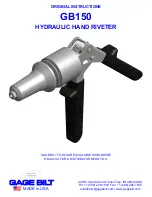
SPECIFIC SAFETY RULES
•
DANGER:
Because of the high working pressures developed by this gun, the possibility of
grease injection into the flesh, or an eye, is a potential hazard. Never allow any part of the
human body to come in front of, or in direct contact with a grease discharge outlet or potential
hose rupture. Never point the nozzle of the gun at yourself or toward anyone else. If accidental
grease injection should occur, seek Immediate Emergency Medical Attention. DO NOT try
to treat the injury yourself!
If injection occurs, provide grease product information to medical personnel. Be
certain that any and all system components will withstand the pressures being developed. Never exceed
the pressure rating of any component in the system. Inspect all hoses and fittings before each use. Weak, worn, or
damaged hoses are a hazard.
• WARNING: Before each use, inspect hoses for signs of wear, leaks, or loose fittings. Inspect and tighten all fluid
connections regularly and replace weak or damaged hose. Do not use any defective, unmarked, or damaged hoses.
Do not repair the grease whip hose. Replace if damaged.
Most injections occur because of component
rupture. Any cuts or sharp bends in hose can rupture and cause personal injury. Use only components that will
withstand the pressures being developed.
• WARNING: Do not adjust relief pressure valve.
• WARNING: Wear safety goggles or other eye protection. Grease gun can develop high pressure – up to 6000 psi (408
bar). Use safety glasses and gloves for protection during operation. Grease leaks under pressure can penetrate the
eyes and skin. Keep grease products away from eyes. Consult grease product labeling for safety precautions.
• CAUTION: Keep hands and fingers clear of the exposed rubber or plastic portion of hose. Extreme pressure may
cause nozzle extension or hose to burst.
• CAUTION: Wipe up any dripped or spilled grease residue and keep work area clean. Grease on floor surfaces can be
slippery and cause loss of footing and possible injury.
A
DDITIONAL SAFETY RULES
The battery pack is not fully charged out of the carton.
Read and understand all of the
safety instructions, then follow the battery charging instructions that follow.
Important Safety Instructions for Battery Pack:
BEFORE USING THE BATTERY PACK AND CHARGER, READ AND UNDERSTAND ALL OF THE SAFETY
INSTRUCTIONS BELOW.
• Do not incinerate the battery pack even if it is severely damaged or is completely worn out. The battery pack can
explode in a fire.
• A small leakage of liquid from the battery pack cells may occur under extreme usage or temperature conditions.
If
this leakage gets on your skin:
a. Wash quickly with soap and water.
b. Neutralize with a mild acid such as lemon juice or vinegar.
c. If battery liquid gets into your eyes, flush them with clean water for a minimum of 15 minutes and seek
immediate medical attention.
Medical note:
The battery cells are rechargeable nickel-cadmium type.
• A battery operated tool with integral batteries or a separate battery pack must be recharged only with the specified
charger for the battery.
A charger that may be suitable for one type of battery may create a risk of fire when used with
another battery.
• Use battery operated tool only with specifically designated battery pack.
Use of any other batteries may create a risk of
fire. DO NOT substitute or modify another battery to use with your grease gun. When ordering replacement battery packs, be
sure to indicate the specific part number for your tool.
• Disconnect battery pack from tool or place the switch in the locked or off position before making any adjustments,
changing accessories, or storing the tool.
Such preventive safety measures reduce the risk of starting the tool accidentally.
•
When battery pack is not in use, keep it away from other metal objects like: paper clips, coins, keys, nails, screws, or other
small metal objects that can make a connection from one terminal to another. Shorting the battery terminals together may
cause sparks, burns, or a fire.
•
Charge battery pack only in a Legacy charger made for this specific tool model.
• Do not splash battery pack or charger with water or other liquids.
Do not use or attempt to charge any battery pack that
has become wet or that has had water splashed or dripped on to it.
• Do not store or use the tool and / or battery pack in locations where the temperature may reach 105˚ F (such as
outside sheds or metal buildings in summer).
• DANGER! Electrocution hazard! Never attempt to open the battery pack for any reason. If battery pack case is
cracked or damaged, do not insert into charger. Electric shock or electrocution may result. Damaged battery
packs should be taken to a battery service center for recycling.
• WARNING: Fire hazard. Do not store or carry battery packs so that metal objects can contact exposed battery
terminals.
Do not place battery pack in aprons, pockets, tool boxes, product kit boxes, drawers, etc., along with other metal
objects. Battery pack terminals could be short-circuited possibly causing severe burns or fire, as well as causing damage to
the battery pack.
• WARNING: Do not transport batteries unless exposed battery contacts are protected and insulated from materials
that could contact them and cause a short circuit.
• CAUTION: Battery pack must be securely attached to tool. If battery pack is detached, personal injury may result.
• IMPORTANT: Dispose of expended or damaged battery packs properly by returning to a local battery service dealer
or contact your local recycling agencies for proper disposal information. Under various state and local laws it may be
illegal to dispose of this battery into the municipal waste stream.

























